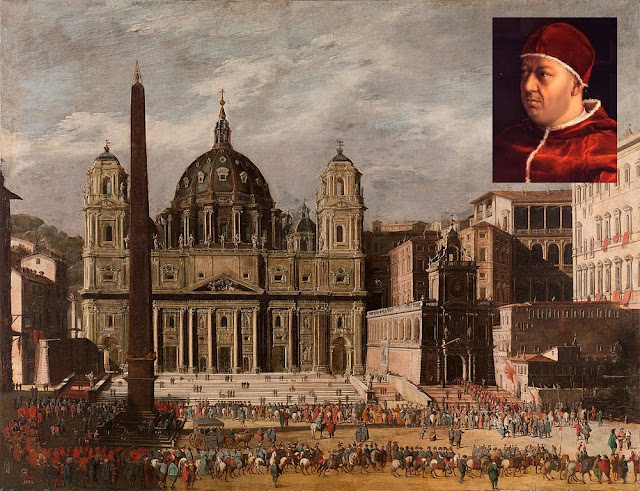 |
| Left: Michelangelo presenting plans for the facade of San Lorenzo to the Medici pope, Leo X. Right: The stemma of Leo XI as seen on the Archepiscopal Palace in Florence. |
The Medici were a Florentine family who were perhaps best known for their positions as bankers during the Renaissance, as well as for effectively bankrolling from their assets what we have now come to think of precisely as the 'renaissance' - a period in which we saw a flowering of creativity and knowledge in everything from art to science to cuisine. The Medici family actually produced four popes, Leo X (1475-1521), Clement VII (1478-1534), Pius IV (1499-1565) and Leo XI (1535-1605) -- the latter of which only reigned as pope for 27 days and as such our focus today is on the first three.
Down to our own time, when one walks through the beautiful streets of Florence, the presence of the Medici family remains tangible and visible. As far as their careers with the papacy are concerned, while none of the Medici popes were ever sainted, it is their legacy in their continuation of the Medici family tradition as acting of patrons of the arts (if not also other domains that go beyond the scope of this site) that are of interest for us here.
The first Medici to become pope was Leo X, who sat on the throne of St. Peter from 1513-1521. He was born Giovanni di Lorenzo de' Medici, the second son of Lorenzo the Magnificent. It was Leo X who undertook the continuation of the project of having St. Peter's Basilica reconstructed (and in point of fact, it was Leo who condemned Martin Luther who had taken issue with the use of indulgences which Leo used to help in the fundraise the reconstruction efforts; interestingly, Luther would later attest to Leo's moral character in a positive manner).
It was also Leo X who worked with now famous artists such as Raphael in the execution of frescoes in the Vatican. He was both a lover of the arts and a patron of it. (As a point of historical note and interest, Leo was also the last pope to have been a pope without having been a priest at the time of his election.)
Following Leo came his cousin, Giulio de' Medici who sat on the throne of St. Peter shortly after his cousin did, reigning from 1523-1534 and taking the name Clement VII. Clement's reign was not deemed particularly successful as a pontificate, though he was known to be personally very devout. However, as far as art is concerned, Clement continued on the Medici family tradition and acted as a patron of the arts, commissioning works from Raphael, Benveneto Cellini and Michaelangelo. In fact, it was Clement who commissioned what is perhaps one of the most famous artworks in the Vatican, Michelangelo's Last Judgement found in the Sistine Chapel.
Twenty five years following Clement's reign, we see our next Medici pope come to the throne in the person of Giovanni Angelo Medici who reigned from 1559-1565 taking the name of Pius IV. While his contributions to ecclesiastical art may not be as significant as his two Medici papal forbears in terms of the significance of the commissions, this particular Medici pope -- who hailed from Milan rather than Florence, and coming from another generation -- was significant in the Church's life insofar as it was he who was responsible for finally reconvening and concluding the Council of Trent -- which his more famous successor, St. Pius V, would then ultimately enact and implement. Artistically speaking, however, Pius IV was noteworth for commissioning Michelangelo to rebuild the church of Santa Maria degli Angeli in Diocletian's Baths.
Suffice it to say, as men and as popes, these Medici popes find both those who praise them and those who detract from them. There is gossip and there is scandal; there is also praise. No man is perfect. For all of this, one must leave these matters in the hands of God of course for it is he who is judge. What we can know for certain for our own part is that these popes -- particularly the first two -- helped to gift the Church with some of the greatest and most influential pieces of ecclesiastical art and architecture the Church has seen; pieces which remain central points of interest to our own day. In this regard, whatever one might choose to think about the Medici, the fact is that their influence not only continues to be felt within the venerable city of Florence, but the world over even centuries later.













